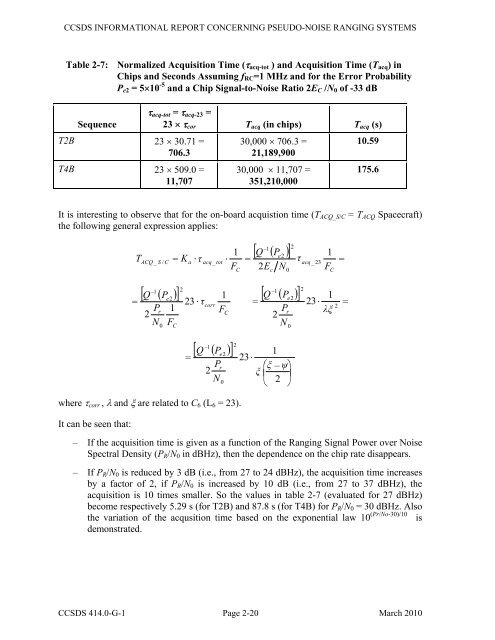Pseudo-Noise (PN) Ranging Systems - CCSDS
Pseudo-Noise (PN) Ranging Systems - CCSDS
Pseudo-Noise (PN) Ranging Systems - CCSDS
Create successful ePaper yourself
Turn your PDF publications into a flip-book with our unique Google optimized e-Paper software.
<strong>CCSDS</strong> INFORMATIONAL REPORT CONCERNING PSEUDO-NOISE RANGING SYSTEMS<br />
Table 2-7: Normalized Acquisition Time (τacq-tot ) and Acquisition Time (Tacq) in<br />
Chips and Seconds Assuming fRC=1 MHz and for the Error Probability<br />
Pe2 = 5×10 -5 and a Chip Signal-to-<strong>Noise</strong> Ratio 2EC /N0 of -33 dB<br />
Sequence<br />
T2B 23 × 30.71 =<br />
706.3<br />
T4B 23 × 509.0 =<br />
11,707<br />
τacq-tot = τacq-23 =<br />
23 × τcor Tacq (in chips) Tacq (s)<br />
30,000 × 706.3 =<br />
21,189,900<br />
30,000 × 11,707 =<br />
351,210,000<br />
10.59<br />
175.6<br />
It is interesting to observe that for the on-board acquistion time (TACQ_S/C = TACQ Spacecraft)<br />
the following general expression applies:<br />
=<br />
T<br />
ACQ _ S / C<br />
= K<br />
a<br />
1<br />
· τ acq_<br />
tot ·<br />
F<br />
C<br />
<strong>CCSDS</strong> 414.0-G-1 Page 2-20 March 2010<br />
=<br />
−1<br />
2 [ Q ( Pe<br />
2 ) ]<br />
2E<br />
− 1 2<br />
−1<br />
[ Q ( P ) ] 1 [ Q ( Pe<br />
2)<br />
]<br />
Pr<br />
2<br />
N<br />
0<br />
e2<br />
1<br />
F<br />
C<br />
23 · τ<br />
=<br />
corr<br />
F<br />
C<br />
−1<br />
[ Q ( P ) ]<br />
e2<br />
Pr<br />
2<br />
N<br />
where τcorr , λ and ξ are related to C6 (L6 = 23).<br />
It can be seen that:<br />
0<br />
2<br />
=<br />
23·<br />
ξ<br />
c<br />
N<br />
0<br />
Pr<br />
2<br />
N<br />
0<br />
1<br />
ξ − ψ<br />
2<br />
τ<br />
acq_<br />
23<br />
2<br />
1<br />
F<br />
C<br />
1<br />
23 ·<br />
λξ<br />
– If the acquisition time is given as a function of the <strong>Ranging</strong> Signal Power over <strong>Noise</strong><br />
Spectral Density (PR/N0 in dBHz), then the dependence on the chip rate disappears.<br />
– If PR/N0 is reduced by 3 dB (i.e., from 27 to 24 dBHz), the acquisition time increases<br />
by a factor of 2, if PR/N0 is increased by 10 dB (i.e., from 27 to 37 dBHz), the<br />
acquisition is 10 times smaller. So the values in table 2-7 (evaluated for 27 dBHz)<br />
become respectively 5.29 s (for T2B) and 87.8 s (for T4B) for PR/N0 = 30 dBHz. Also<br />
the variation of the acqusition time based on the exponential law 10 (Pr/No-30)/10 is<br />
demonstrated.<br />
2<br />
=<br />
=

















